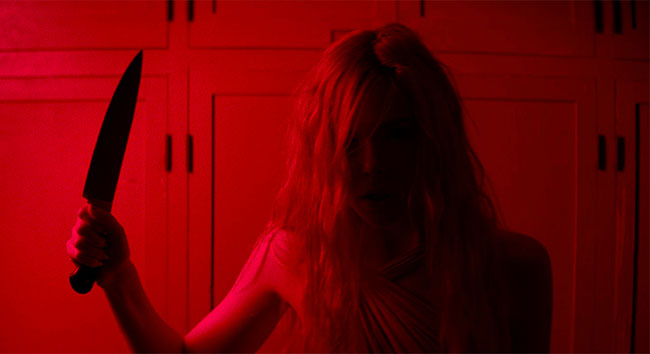I have never seen so many people walk out of a movie before. And I once saw the midnight showing of The Last Airbender.
Granted, The Neon Demon — Nicolas Winding Refn’s hellish landscape of bright lights and selfish souls — is a better film than M. Night Shyamalan’s should-be career ender. The latter upset hundreds of moviegoers for simply being godawful, but The Neon Demon is destined to court controversy for entirely different reasons.
If Refn’s blatant, in-your-face presentation of disturbing imagery suggests anything, it’s that he was more interested in sickening people who would inevitably talk about his movie than he was in telling a worthwhile story. The Neon Demon is slick style that’s drowned out by shock factor schlock substance.
Let’s assume you’re reading this review solely because you’re trying to decide whether or not to buy a ticket. If so: definitely do not take children to this movie. If you are easily bothered by violence or sexual content, do not see it. Don’t let the MPAA’s notoriously fickle standards confuse you: The Neon Demon deserves an NC-17 rating. It got off easy with an R rating.
Now let’s get a little more in depth. Like the movie itself, we’ll start off with what’s good. Nicolas Winding Refn’s best films are revered for notable reasons: sexy visual style with a dash of hyperviolence, absorbing soundtracks, and actors that give fantastic performances without talking much at all. His most honored work, the arthouse thriller Drive, was a transcendent experience because it used these aspects in service of characters and the dreamy romance between them.
The Neon Demon retains all of these stylistic trademarks. During the first half of the movie, much of the storytelling is done through inventive visual aesthetic. The sinister, self-absorbed stage of LA’s modeling world is set by jealous glances and flashy reflections rather than exposition. Deliberately disconcerting cinematography bathes clubs and gigs in a dangerous neon luster. The soundtrack proves that EDM is actually good for something (not sorry, EDM fans) with thumping music that alternately builds and dissolves tension.
Jena Malone epitomizes the movie’s tone with a performance that’s both entrancing and off-putting; Keanu Reeves shows up briefly as a sleazy motel manager and earns nervous laughter. Elle Fanning, only 17 at the time of filming, is electrifying as a young girl who moves from self-doubt to self-worship as modeling agencies and photographers glorify her.
Her transition unfortunately marks the beginning of style overcoming substance rather than serving it. A stunning visual sequence represents her black-and-white morality change (or in this case blue-to-red), but it also makes her character wholly unconvincing, as it crams all her development into one scene. From that point on, Refn relies on revolting imagery to carry his film.
The director is full of himself: his initials appear in large lettering multiple times before the opening credits finish, his style grows in self-indulgence with each movie, and he recently described himself as “punk rock in all its glam and vulgarity”. With The Neon Demon he seems to fold his arms and smugly say, “I’ve established my themes with glam, now let me see how vulgar I can get while you still call this art”.
The second half of the movie is rife with inexcusable events that left the majority of the theater disgusted. The film medium is intrinsically meant to mirror human existence: it is art created by humans; our experiences inform the artistic visions that we project. As such, some of the horrible things that happen in real life happen in movies, but the artist’s responsibility is to frame these things in a context that helps us understand them, empathize with the people involved, or even disempower them with a comedic spin.
Otherwise, the artist becomes like Nicolas Winding Refn, who utilizes truly horrid moral awfulness without context or reason just to provoke and cross boundaries. If you have, say, graphic necrophilia in your movie, you’d better have the context and thematic depth to justify it. Refn and The Neon Demon fail this goal.
★★½ (2.5 out of 5)




